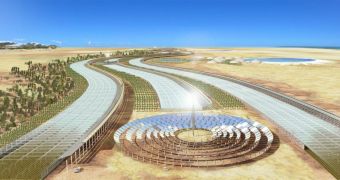This coming December, Qatar will witness the debut of a greenhouse built smack in the middle of the desert.
The people behind this project claim that their greenhouse will do more than just turn these otherwise lifeless areas into fertile regions where crops can be grown and fresh water can be produced.
Thus, they claim that their facility will provide important insights into how to better push for sustainability.
“The Sahara Forest Project has a vision of creating re-vegetation and green jobs through profitable production of food, water, clean electricity and biomass in desert areas,” reads the official website for this green-oriented project.
Furthermore, “The Sahara Forest Project is designed to utilize what we have enough of to produce what we need more of, using deserts, saltwater and CO2 to produce food, water and energy.”
Apparently, the idea that the desert can successfully be used in order to grow crops, produce fresh water and harvest renewables all at the same time first came up back in 2008.
However, it took quite some time (and about $5.3 million / €4.17 million) before this one-hectare man-made oasis began to take shape. Besides growing crops, this facility will also be engaged in algae production.
The working principles behind this project are pretty straightforward: concentrated solar power is used to bring in seawater, which is later on desalinated and made to humidify the air.
Once it performs this task, it is allowed to condensate and freshwater with which to irrigate the plants is obtained.
“The Pilot Project is designed to fit in an approximately 10,000 m2 area inside the Qafco 5 site in Qatar and will consist of seawater-based greenhouses, concentrated solar power (CSP) for heat & electricity, evaporative hedges and ponds for reducing brine to dry salts, algae cultivation facilities, vegetated outdoor areas and halophyte cultivation units,” said Al Sowaldi, one of the specialists involved in this study.

 14 DAY TRIAL //
14 DAY TRIAL //